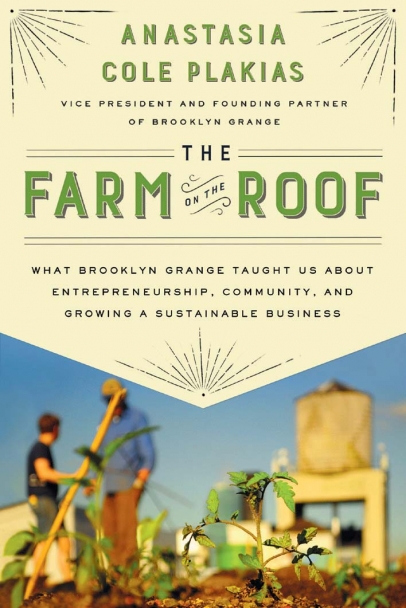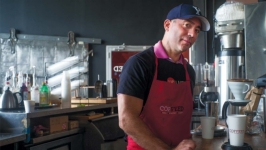The Farm On the Roof
The quintessential American dream—or at least a common New Yorker’s dream—goes something like this: Quit well-paid but thankless cubicle job to pursue a less glamorous but more fulfilling life on the farm, working knee-deep in rich, earthy soil with an elevated sense of purpose. For the scrappy, green thumbed entrepreneurs chronicled in The Farm on the Roof, a new book about the world’s largest rooftop soil farm, this idea flourished beyond daydreams into reality—with a few obstacles along the way.
Penned by the farm’s co-founder, Anastasia Cole Plakias, this memoir-cum-business advice book chronicles the conceptualization, creation and growth of Brooklyn Grange, an urban farm growing and distributing 50,000 pounds of organic produce each year. Though the incorporated name was Brooklyn Grange from the beginning, the farm eventually found its first home on a 43,000-square-foot building on Northern Boulevard in Queens. In addition to this location, founded in 2010, the rooftop farm has also expanded into a second location in the Brooklyn Navy Yard, bringing their total growth area to 2.5 acres of elevated soil.
In The Farm on the Roof, Cole Plakias paints a familiar portrait: A group of young Brooklynites are tired of their suffocating, corporate lives and eager to do something that will bring new life to their local economy and new meaning to their own lives. Following the economic crisis of 2008, this group did the unthinkable, leaving behind their promising careers to create something that many deemed impossible: a profitable farm hovering above the gritty streets of New York that satisfied the “Three Ps: People, Planet and Profit.”
“In an industry as fickle, susceptible and lean as farming—and in an economic climate as competitive as the one in which we found ourselves—success was not a given,” Cole Plakias writes in her introduction, noting that while the group did eventually achieve success, it didn’t come easily. The majority of the memoir focuses on these obstacles— some familiar to startups, and others unique to farming itself.
Perhaps the most laborious hurdle for the group was finding a location to accommodate such an operation. It had to be big, yes, but also easily accessible, affordable and architecturally sound enough to maintain the weight of 100 pounds of soil per square foot—not to mention have a landlord willing to permit that much dirt to be dumped atop their building.
Then came everything else: construction, crowdfunding, attracting investors, expanding operations, cutting through government red tape, finding extra means of profitability, and grappling with everything from rooftop winds to the shifts of the seasons. Overall, Cole Plakias’ book reads less like an advice book—though there are certainly insights that aspiring farmers will find useful— and more like a testament to the hard work the entire Brooklyn Grange “farmily” has put in. In addition to being a letter of thanks to her team and an ode to urban agriculture, The Farm on the Roof is also a love letter to the other small, scrappy businesses of their city—from Bushwick pizzeria Roberta’s, to the charitable COFFEED café, to Saxelby Cheese and Sixpoint Brewery—a who’s who of the Brooklyn small business in-crowd.
Though this book—and their stillgrowing operation—is far from perfect, as the author writes: “Perfection is the enemy of good, and done is better than perfect.” While more celebratory than particularly instructional, Cole Plakias’ account of the rise of Brooklyn Grange and its continued efforts towards success is a charming and uplifting read for anyone with entrepreneurial aspirations and a passion for soil and seeds.
The Farm on the Roof. By Anastasia Cole Plakias (Avery, 2016)
Anastasia Cole Plakias | @anastasiacolenyc
Brooklyn Grange | @brooklyngrange
Roberta’s | @robertaspizza
COFFEED café | @coffeednyc
Saxelby Cheese | @saxelbycheese
Sixpoint Brewery | @sixpoint





